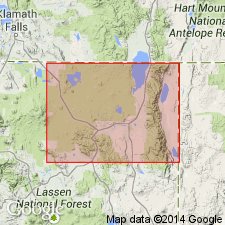
- Usage in publication:
-
- Owl Creek Formation
- Modifications:
-
- Named
- Geochronologic dating
- Dominant lithology:
-
- Basalt
- AAPG geologic province:
-
- Modoc Plateau province
- Great Basin province
Summary:
Unit is named the Owl Creek Formation. Composed of olivine basalt flows which are locally highly vesicular and some flows have large tabular labradorite crystals similar to "Steens" basalts to the north. Has average thickness of 20 ft. Stratigraphic chart shows unit overlies the Squaw Peak Formation [rocks now included in Cedar Pass complex (informal). See Cedar Pass]; underlies the Patterson Tuff. A K-Ar age of about 13.7 Ma was obtained from one of the flows (Duffield, personal commun.). Age is Miocene.
[Proposal conflicts with several articles in nomenclature guidelines (ACSN, 1961, 1970; NACSN, 1983, 2005, 2021). Not adopted by the California Geological Survey or the USGS.]
Source: Modified from GNU records (USGS DDS-6; Menlo GNULEX).
For more information, please contact Nancy Stamm, Geologic Names Committee Secretary.
Asterisk (*) indicates published by U.S. Geological Survey authors.
"No current usage" (†) implies that a name has been abandoned or has fallen into disuse. Former usage and, if known, replacement name given in parentheses ( ).
Slash (/) indicates name conflicts with nomenclatural guidelines (CSN, 1933; ACSN, 1961, 1970; NACSN, 1983, 2005, 2021). May be explained within brackets ([ ]).

